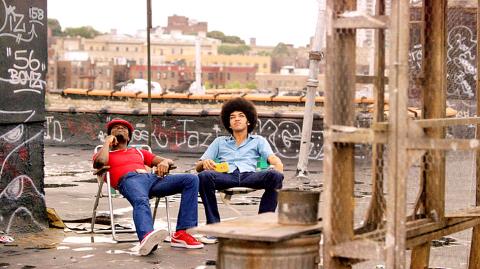Nostalgia is too big a force in pop culture to belong to any one institution. But Netflix owns a bigger percentage of it than most, simply because the past is built into its business model.
“If you liked that, you’ll like this” is the watchword of the streaming service’s algorithm. But it’s also the essence of cultural nostalgia: the longing to find some “this” that reproduces the cherished pleasures of some long-ago “that.”
As Netflix has shown us, there are different ways to chase the thrills of yesterday. You can reboot it, as when Fuller House brought the characters of Full House into this year. You can revive it, as with the coming continuation of Gilmore Girls.

Photo: Alberto E. Rodriguez/Getty Images/AFP
Or — as in Netflix’s two throwback shows of the summer, Stranger Things and The Get Down — you can rethink it.
Neither of them — unlike this year’s The X-Files or Ghostbusters — is based on an existing franchise. They tickle our memory centers without inviting unflattering comparisons to some sainted original. They might succeed or not, but they’re at least trying to reproduce part of what made us love our childhood favorites way back when: the joy of discovering something for the first time.
‘STRANGER THINGS’

Photo courtesy of Netflix
With Stranger Things, Matt and Ross Duffer have made something you might imagine coming from child prodigies who grew up in an abandoned Blockbuster full of VHS tapes, a monster sewn from pieces of Steven Spielberg, Stephen King, Wes Craven and more.
Part of the series’ pleasure is how well it re-creates the details not only of life in 1983 but also of storytelling in 1983, from the synth music to the Benguiat typeface of the title credits. (This was also the mode of Red Oaks on Amazon and Netflix’s Wet Hot American Summer: First Day of Camp.) It even cast Winona Ryder, star of the 1988 Heathers, in the same talismanic way that Quentin Tarantino recruited the 1970s icon Pam Grier for the blaxploitation-inspired Jackie Brown.
In its individual pieces, Stranger Things is an Easter-egg salad of references, story lines and tropes. What elevates the series is the way it looks back on its inspirations with the benefit of hindsight. (Or at least secondhand hindsight: the Duffers, twin brothers, were born in 1984, a year after the season takes place.) The vintage artifacts are scuffed, some of the Spielbergian glow rubbed off. Its Indiana hometown feels a little rusty and dangerous, even before the monster and wicked scientists turn up.
As Joyce, whose son Will is sucked into a parallel plane of existence, Ryder plays the kind of single-mom character common in movies like E.T. the Extraterrestrial from the early ‘80s, a time of high divorce rates. But her circumstances are a little more raw and dire. (It’s a financial hardship, for instance, for her to replace the landline phone Will blows up in his attempt to communicate.) The teenage characters, meanwhile, both recall and respond to their horror-movie forebears, like Nancy (Natalia Dyer), who has sex with her boyfriend yet doesn’t become monster food as punishment.
Stranger Things isn’t revolutionary — it’s a tasty campfire s’more, the kind of summer movie that the actual summer movie season didn’t provide. But it manages to deliver on the appeal of nostalgia — the allure of simpler, innocent times — while letting on that it realizes those times were neither simpler nor more innocent.
‘THE GET DOWN’
The Get Down performs the opposite trick: It takes a period fixed in popular history as a nadir and turns it into a moment shimmering with possibility.
From Spike Lee’s Summer of Sam to the ESPN miniseries The Bronx Is Burning (based on a book by The New York Times’ Jonathan Mahler), 1977 has been portrayed as the year New York City bottomed out. The Get Down, a fanciful origin story of hip-hop in the Bronx, presents it as the year a new urban culture impossibly took flight.
Part of this is the influence of the creator Baz Luhrmann, who has never met a subject he wouldn’t blast with a glitter cannon. The sensibility of The Get Down is defiantly joyous, more The Wiz than The Warriors. There may be arson-torched apartment buildings and gaudily art-directed murders, but the series’ true love is for orange limousines and tight, bumping disco pants.
The show’s stylistic pastiche is less blatant than those in Stranger Things, but it even more forcefully wrestles with the popular conception of its setting. Where we expect to see problems, it sees opportunities — chances for invention and self-invention, even if it takes struggle.
Compared with HBO’s somber and now-canceled 1970s music drama, Vinyl, The Get Down is mainly a young people’s story. It refuses to be pessimistic, and it’s cast with vibrant young actors like Justice Smith and Herizen Guardiola, whose performances each contain a full day’s supply of vitamin C.
Like Stranger Things, with its brick-size walkie-talkies, The Get Down fetishizes predigital technology (here, turntables and crayon-marked LPs) as a means of liberating ingenious kids. Midseason, the Bronx is hit by the notorious blackout of 1977, whose chaos and looting got record players and mixing boards into the hands of the youth, written off, who will help create an American art form.
Stranger Things is much more fully formed. The Get Down is plagued by an undisciplined ambition to be every story — melodrama, history, romance, musical comedy, political intrigue. It has electric moments, but only becomes focused intermittently, in the last couple hours of its six-episode initial run.
But both shows are encouraging examples of how to use nostalgia for more than cheap hits of Remember that? Not unlike the DJs of The Get Down, they practice a kind of scavenger’s art, weaving samples and familiar hooks into kinetic new rhythms. There’s no shortage of TV that invites us to relive the past, but it can be much more rewarding to remix it.

June 9 to June 15 A photo of two men riding trendy high-wheel Penny-Farthing bicycles past a Qing Dynasty gate aptly captures the essence of Taipei in 1897 — a newly colonized city on the cusp of great change. The Japanese began making significant modifications to the cityscape in 1899, tearing down Qing-era structures, widening boulevards and installing Western-style infrastructure and buildings. The photographer, Minosuke Imamura, only spent a year in Taiwan as a cartographer for the governor-general’s office, but he left behind a treasure trove of 130 images showing life at the onset of Japanese rule, spanning July 1897 to

One of the most important gripes that Taiwanese have about the Democratic Progressive Party (DPP) is that it has failed to deliver concretely on higher wages, housing prices and other bread-and-butter issues. The parallel complaint is that the DPP cares only about glamor issues, such as removing markers of Chinese Nationalist Party (KMT) colonialism by renaming them, or what the KMT codes as “de-Sinification.” Once again, as a critical election looms, the DPP is presenting evidence for that charge. The KMT was quick to jump on the recent proposal of the Ministry of the Interior (MOI) to rename roads that symbolize

On the evening of June 1, Control Yuan Secretary-General Lee Chun-yi (李俊俋) apologized and resigned in disgrace. His crime was instructing his driver to use a Control Yuan vehicle to transport his dog to a pet grooming salon. The Control Yuan is the government branch that investigates, audits and impeaches government officials for, among other things, misuse of government funds, so his misuse of a government vehicle was highly inappropriate. If this story were told to anyone living in the golden era of swaggering gangsters, flashy nouveau riche businessmen, and corrupt “black gold” politics of the 1980s and 1990s, they would have laughed.

It was just before 6am on a sunny November morning and I could hardly contain my excitement as I arrived at the wharf where I would catch the boat to one of Penghu’s most difficult-to-access islands, a trip that had been on my list for nearly a decade. Little did I know, my dream would soon be crushed. Unsure about which boat was heading to Huayu (花嶼), I found someone who appeared to be a local and asked if this was the right place to wait. “Oh, the boat to Huayu’s been canceled today,” she told me. I couldn’t believe my ears. Surely,